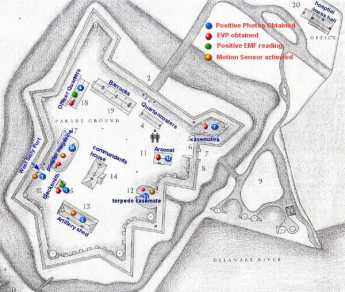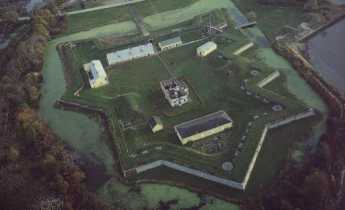1 Volumes
Revolutionary War Era
The shot heard 'round the world.
Battle of Fort Miflin
New topic 2017-02-13 23:47:21 description
Fort Mifflin

|
| Map of Fort Mifflin |
The Administrator of Fort Mifflin, Beth Beatty, recently addressed the Franklin Inn Club about it. The famous fort, whose defeat marked the end of Philadelphia's resistance to the British invasion, is now owned by the City of Philadelphia, hidden behind the approaches to the International Airport. It shows a lot of signs of two centuries of wear and tear because for a number of decades after the Revolution it was still in use as a fortification. Built on a swamp, one most notable feature is it can be very wet, much of the time, and is subject to repeated floods that most of us on the higher ground pass off as rainstorms. But it's still there, and it must be pretty sturdy.
British frigates were patrolling upper Delaware well before July 4, 1776, and Benjamin Franklin was a member of the Committee on Safety. As such, he is given credit for inventing the chevaux de frise, which filled in the gaps in the mudflats at the turn of the river. These inventions are best imagined as the "do not reverse" treadles of modern parking lots, buried in the riverbed and quite effectively preventing the sailing ships of the day from passing upstream. Fort Mercer was placed on a small bluff protecting the New Jersey side, and Fort Mifflin held the Pennsylvania side of the river, but more notably wallowing in the mud.

|
| Fort Mifflin |
The fort has been named after Thomas Mifflin, Pennsylvania's first governor. Unfortunately, Mifflin was the main conspirator in the so-called Conway Cabal which later tried to dislodge George Washington from the role of Commander while he was still at Valley Forge. Mifflin was a total drunkard, and behaved disgracefully as Governor, signing over huge plots of state land to himself, along with his subverted controller, John Nicholson. Much of the bankruptcy of Robert Morris can be traced to the manipulations of these two colonials, although that famous bankruptcy played such a central role in the political arguments of the early 19th Century it will probably always be difficult to be sure where to place blame. Since Morris was one of the three men (along with Franklin and Washington) without whom the Revolution could not have been won, his responsibility in the post-war land speculations tends to benefit from shifting the burden of proof toward the other two participants, perhaps even accurately.

|
| Fort Mifflin Powder Room |
An interesting part of the Fort Mifflin site is to discover that the powder magazines were buried underneath the foundation footings of the main brick defensive wall. The gunpowder effectively had a roof of the entire main wall. That made it particularly difficult for cannon fire to ignite the gunpowder stores and probably played a large role in the ability of the Fort to hold out against the British for considerably longer than anyone expected. Since the fort had been built while the British were still in control before the Revolution, the attackers were eventually able to consult with the architect, who advised them to bombard the Pennsylvania side of it, which was mainly made of mud rather than solid brick. It should be remembered that the British had disembarked at the Head of Elk in Maryland when they launched the original attack behind Philadelphia. They thus carried minimal supplies and food on what was mainly a cavalry charge, taking a great risk they would not be able to rejoin the British fleet in time. The fleet circled back down the Chesapeake Bay and returned up to the Eastern Maryland coast to Delaware Bay. When they found their way blocked for days and weeks at Fort Mifflin, Lord Howe's troops inside Philadelphia were at great risk of starving, and/or running out of ammunition. Washington seems to have recognized the advantages he had and was willing to sacrifice the fort for a prolonged defense. The British Navy on the downside of the Fort, equally aware of the need to break through quickly, pummelled the Fort with thousands of cannon shot and shell. The Americans inside the fort adopted the ingenious strategy of building the walls up at night, ready at dawn to withstand another day of bombardment. It has been reported that most of Ft. Mifflin's defenders were teen-aged boys, perhaps mostly overestimating the odds of their own survival.
It was a gallant try, but eventually the overwhelming force of the British Navy broke through. The American capital had been taken.
1 Blogs
Fort Mifflin
 Ordered by George Washington to fight on "to the utmost extremity", the Revolutionary War defenders of Fort Mifflin came close to defeating the British Navy.
Ordered by George Washington to fight on "to the utmost extremity", the Revolutionary War defenders of Fort Mifflin came close to defeating the British Navy.